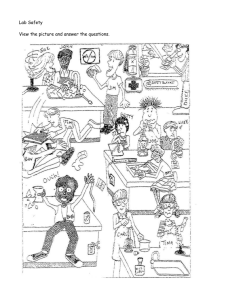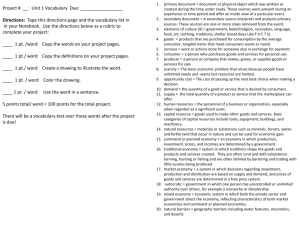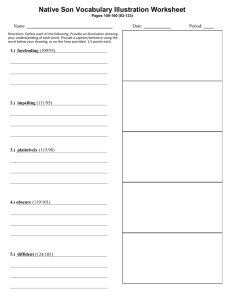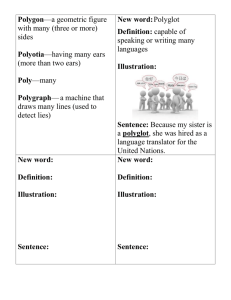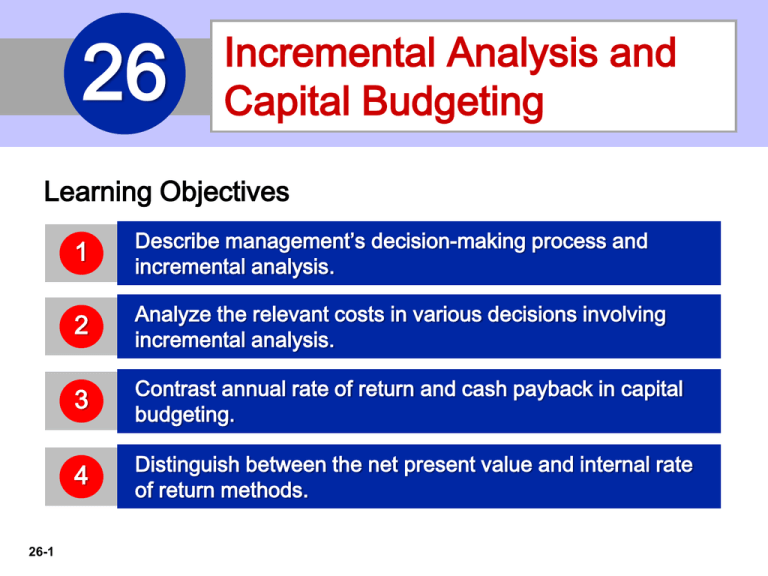
26
Incremental Analysis and
Capital Budgeting
Learning Objectives
26-1
1
Describe management’s decision-making process and
incremental analysis.
2
Analyze the relevant costs in various decisions involving
incremental analysis.
3
Contrast annual rate of return and cash payback in capital
budgeting.
4
Distinguish between the net present value and internal rate
of return methods.
LEARNING
OBJECTIVE
1
Describe management’s decision-making process
and incremental analysis.
Making decisions is an important management function.
Does not always follow a set pattern.
Decisions vary in scope, urgency, and importance.
Steps usually involved in process include:
Illustration 26-1
Management’s decision-making process
26-2
LO 1
Decision-Making Process
In making business decisions,
Considers both financial and non-financial information.
Financial information
26-3
►
Revenues and costs, and
►
Effect on overall profitability.
Nonfinancial information
►
Effect on employee turnover
►
The environment
►
Overall company image.
LO 1
Incremental Analysis Approach
26-4
Decisions involve a choice among alternative actions.
Process used to identify the financial data that change
under alternative courses of action.
►
Both costs and revenues may vary or
►
Only revenues may vary or
►
Only costs may vary
LO 1
How Incremental Analysis Works
Illustration 26-2
Basic approach in incremental analysis
Alternative B
26-5
Incremental revenue is $15,000 less.
Incremental cost savings of $20,000 is realized.
Produces $5,000 more net income.
LO 1
How Incremental Analysis Works
Important concepts used in incremental analysis:
26-6
Relevant cost
Opportunity cost
Sunk cost
LO 1
How Incremental Analysis Works
26-7
Sometimes involves changes that seem contrary to
intuition.
Variable costs sometimes do not change under
alternatives.
Fixed costs sometimes change between alternatives.
LO 1
Service Company Insight
American Express
That Letter from AmEx Might Not Be a Bill
No doubt every one of you has received an invitation from a
credit card company to open a new account—some of you have
probably received three in one day. But how many of you have
received an offer of $300 to close out your credit card account?
American Express decided to offer some of its customers $300 if
they would give back their credit card. You could receive the
$300 even if you hadn’t paid off your balance yet, as long as you
agreed to give up your credit card.
Source: Aparajita Saha-Bubna and Lauren Pollock, “AmEx Offers Some
Holders $300 to Pay and Leave,” Wall Street Journal Online (February
23, 2009).
26-8
LO 1
Types of Incremental Analysis
Common types of decisions involving incremental analysis:
1. Accept an order at a special price.
2. Make or buy component parts or finished products.
3. Sell or process further them further.
4. Repair, retain, or replace equipment.
5. Eliminate an unprofitable business segment or product.
26-9
LO 1
Incremental Analysis
Question
Incremental analysis is the process of identifying the financial
data that
a. Do not change under alternative courses of action.
b. Change under alternative courses of action.
c. Are mixed under alternative courses of action.
d. None of the above.
26-10
LO 1
DO IT! 1
Incremental Analysis
Owen T Corporation is comparing two different options. The
company currently follows Option 1, with revenues of $80,000 per
year, maintenance expenses of $5,000 per year, and operating
expenses of $38,000 per year. Option 2 provides revenues of
$80,000 per year, maintenance expenses of $12,000 per year, and
operating expenses of $32,000 per year. Option 1 employs a piece
of equipment that was upgraded 2 years ago at a cost of $22,000. If
Option 2 is chosen, it will free up resources that will increase
revenues by $3,000.
Complete the following table to show the change in income from
choosing Option 2 versus Option 1. Designate any sunk costs with
an “S.”
26-11
LO 1
The company currently follows Option 1, with revenues of $80,000
per year, maintenance expenses of $5,000 per year, and operating
expenses of $38,000 per year. Option 2 provides revenues of
$80,000 per year, maintenance expenses of $12,000 per year, and
operating expenses of $32,000 per year. Option 1 employs a piece
of equipment that was upgraded 2 years ago at a cost of $22,000. If
Option 2 is chosen, it will free up resources that will increase
revenues by $3,000.
26-12
LO 1
LEARNING
OBJECTIVE
2
Analyze the relevant costs in various decisions
involving incremental analysis.
Special Price Order
26-13
Obtain additional business by making a major price
concession to a specific customer.
Assumes that sales of products in other markets are
not affected by special order.
Assumes that company is not operating at full capacity.
LO 2
Accept an Order at a Special Price
Illustration: Sunbelt Company produces 100,000 Smoothie
blenders per month, which is 80% of plant capacity. Variable
manufacturing costs are $8 per unit. Fixed manufacturing costs are
$400,000, or $4 per unit. The blenders are normally sold directly to
retailers at $20 each. Sunbelt has an offer from Kensington Co. (a
foreign wholesaler) to purchase an additional 2,000 blenders at
$11 per unit. Acceptance of the offer would not affect normal sales
of the product, and the additional units can be manufactured
without increasing plant capacity. What should management do?
26-14
LO 2
Accept an Order at a Special Price
Illustration 26-4
Incremental analysis—accepting
an order at a special price
Fixed costs do not change since within existing capacity – thus fixed
costs are not relevant.
Variable manufacturing costs and expected revenues change – thus
both are relevant to the decision.
26-15
LO 2
DO IT!
2a
Special Orders
Cobb Company incurs costs of $28 per unit ($18 variable and $10
fixed) to make a product that normally sells for $42. A foreign
wholesaler offers to buy 5,000 units at $25 each. Cobb will incur
additional shipping costs of $1 per unit. Compute the increase or
decrease in net income Cobb will realize by accepting the special
order, assuming Cobb has excess operating capacity. Should Cobb
Company accept the special order?
Accept
or
Reject?
26-16
LO 2
Make or Buy
Illustration: Baron Company incurs the following annual costs in
producing 25,000 ignition switches for motor scooters.
Illustration 26-5
Annual product
cost data
Instead of making its own switches, Baron Company might purchase
the ignition switches at a price of $8 per unit. If purchased, $10,000 of
the fixed costs will be eliminated. “What should management do?”
26-17
LO 2
Make or Buy
Illustration 26-6
Incremental analysis—
make or buy
Total manufacturing cost is $1 higher per unit than purchase price.
Must absorb at least $50,000 of fixed costs under either option.
26-18
LO 2
OPPORTUNITY COST
The potential benefit that
may be obtained from
following an alternative
course of action.
26-19
LO 2
OPPORTUNITY COST
Illustration: Assume that through buying the switches, Baron
Company can use the released productive capacity to generate
additional income of $38,000 from producing a different product.
This lost income is an additional cost of continuing to make the
switches in the make-or-buy decision.
26-20
Illustration 26-7
Incremental analysis—make or
buy, with opportunity cost
LO 2
Make or Buy
Question
In a make-or-buy decision, relevant costs are:
a. Manufacturing costs that will be saved.
b. The purchase price of the units.
c. Opportunity costs.
d. All of the above.
26-21
LO 2
Service Company Insight
Amazon.com
Giving Away the Store?
In an earlier chapter, we discussed Amazon.com’s incredible growth. However,
some analysts have questioned whether some of the methods that Amazon
uses to increase its sales make good business sense. For example, a few years
ago, Amazon initiated a “Prime” free-shipping subscription program. For a $79
fee per year, Amazon’s customers get free shipping on as many goods as they
want to buy. At the time, CEO Jeff Bezos promised that the program would be
costly in the short-term but benefit the company in the long-term. Six years later,
it was true that Amazon’s sales had grown considerably. It was also estimated
that its Prime customers buy two to three times as much as non-Prime
customers. But, its shipping costs rose from 2.8% of sales to 4% of sales, which
is remarkably similar to the drop in its gross margin from 24% to 22.3%.
Perhaps even less easy to justify is a proposal by Mr. Bezos to start providing a
free Internet movie-streaming service to Amazon’s Prime customers. Perhaps
some incremental analysis is in order?
Source: Martin Peers, “Amazon’s Prime Numbers,” Wall Street Journal Online (February
3, 2011).
26-22
LO 2
DO IT!
2b
Make or Buy
Juanita Company must decide whether to make or buy some of its
components for the appliances it produces. The costs of producing
166,000 electrical cords for its appliances are as follows.
Direct materials
Direct labor
$90,000
20,000
Variable overhead
Fixed overhead
$32,000
24,000
Instead of making the electrical cords at an average cost per unit of
$1.00 ($166,000 ÷ 166,000), the company has an opportunity to buy the
cords at $0.90 per unit. If the company purchases the cords, all variable
costs and one-fourth of the fixed costs will be eliminated.
(a) Prepare an incremental analysis showing whether the company
should make or buy the electrical cords. (b) Will your answer be different
if the released productive capacity will generate additional income of
$5,000?
26-23
LO 2
DO IT!
2b
Make or Buy
(a) Prepare an incremental analysis showing whether the company
should make or buy the electrical cords.
*$24,000 x .75
**166,000 units x $0.90
Juanita Company will incur $1,400 of additional costs if it buys the
electrical cords rather than making them.
26-24
LO 2
DO IT!
2b
Make or Buy
(b) Will your answer be different if the released productive capacity
will generate additional income of $5,000?
Yes, net income will be increased by $3,600 if Juanita Company
purchases the electrical cords rather than making them.
26-25
LO 2
Sell or Process Further
May have option to sell product at a given point in
production or to process further and sell at a higher
price.
Decision Rule:
Process further as long as the incremental revenue from
such processing exceeds the incremental processing
costs.
26-26
LO 2
Sell or Process Further
Illustration: Woodmasters Inc. makes tables. The cost to
manufacture an unfinished table is $35. The selling price per
unfinished unit is $50. Woodmasters has unused capacity that
can be used to finish the tables and sell them at $60 per unit. For
a finished table, direct materials will increase $2 and direct labor
costs will increase $4. Variable manufacturing overhead costs will
increase by $2.40 (60% of direct labor). No increase is
anticipated in fixed manufacturing overhead.
Illustration 26-8
Per unit cost of
unfinished table
26-27
LO 2
Sell or Process Further
The incremental analysis on a per unit basis is as follows.
Illustration 26-9
Incremental analysis—
sell or process further
26-28
Should Woodmasters sell or process further?
further.
LO 2
Sell or Process Further
Question
The decision rule in a sell-or-process-further decision is:
Process further as long as the incremental revenue from
processing exceeds:
a. Incremental processing costs.
b. Variable processing costs.
c. Fixed processing costs.
d. No correct answer is given.
26-29
LO 2
DO IT!
2c
Sell or Process Further
Easy Does It manufactures unpainted furniture for the do-it-yourself
(DIY) market. It currently sells a child’s rocking chair for $25. Production
costs are $12 variable and $8 fixed. Easy Does It is considering painting
the rocking chair and selling it for $35. Variable costs to paint each chair
are expected to be $9, and fixed costs are expected to be $2.Prepare an
analysis showing whether Easy Does It should sell unpainted or painted
chairs.
Solution
26-30
LO 2
Repair, Retain, or Replace Equipment
Illustration: Jeffcoat Company is considering replacing a factory
machine with a new machine. Jeffcoat Company has a factory
machine that originally cost $110,000. It has a balance in
Accumulated Depreciation of $70,000, so its book value is $40,000. It
has a remaining useful life of four years. The company is considering
replacing this machine with a new machine. A new machine is
available that costs $120,000. It is expected to have zero salvage
value at the end of its four-year useful life. If the new machine is
acquired, variable manufacturing costs are expected to decrease from
$160,000 to $125,000 and the old unit could be sold for $5,000. The
incremental analysis for the four-year period is as follows.
26-31
LO 2
Repair, Retain, or Replace Equipment
Prepare the incremental analysis for the four-year period.
Illustration 26-10
26-32
Retain or Replace?
LO 2
Repair, Retain, or Replace Equipment
Additional Considerations
26-33
The book value of old machine does not affect the decision.
►
Book value is a sunk cost.
►
Costs which cannot be changed by future decisions (sunk
cost) are not relevant in incremental analysis.
However, any trade-in allowance or cash disposal value of
the existing asset is relevant.
LO 2
DO IT!
2d
Repair or Replace Equipment
Rochester Roofing is faced with a decision. The company relies very
heavily on the use of its 60-foot extension lift for work on large homes
and commercial properties. Last year, the company spent $60,000
refurbishing the lift. It has just determined that another $40,000 of repair
work is required. Alternatively, Rochester Roofing has found a newer
used lift that is for sale for $170,000. The company estimates that both
the old and new lifts would have useful lives of 6 years. However, the lift
is more efficient and thus would reduce operating expenses by about
$20,000 per year. The company could also rent out the new lift for about
$2,000 per year. The old lift is not suitable for rental. The old lift could
currently be sold for $25,000 if the new lift is purchased.
Prepare an incremental analysis that shows whether the company
should repair or replace the equipment.
26-34
LO 2
DO IT!
2d
Repair or Replace Equipment
Solution
The analysis indicates that purchasing the new machine would
increase net income for the 6-year period by $27,000.
26-35
LO 2
Eliminate an Unprofitable Segment or
Product
26-36
Key: Focus on Relevant Costs.
Consider effect on related product lines.
Fixed costs allocated to the unprofitable segment must be
absorbed by the other segments.
Net income may decrease when an unprofitable segment
is eliminated.
Decision Rule: Retain the segment unless fixed costs
eliminated exceed contribution margin lost.
LO 2
Eliminate an Unprofitable Segment or
Product
Illustration: Venus Company manufactures three models of tennis
rackets:
Profitable lines: Pro and Master
Unprofitable line: Champ
Should Champ
be eliminated?
Illustration 26-11
Segment income data
26-37
LO 2
Eliminate an Unprofitable Segment or
Product
Prepare income data after eliminating Champ product line. Assume
fixed costs are allocated 2/3 to Pro and 1/3 to Master.
Illustration 26-12
Income data after eliminating
unprofitable product line
26-38
Total income is decreased by $10,000.
LO 2
Eliminate an Unprofitable Segment or
Product
Incremental analysis of Champ provided the same results:
Do Not Eliminate Champ
26-39
Illustration 26-13
Incremental analysis—eliminating unprofitable
segment with no reduction in fixed costs
LO 2
Unprofitable Segments
Question
If an unprofitable segment is eliminated:
a. Net income will always increase.
b. Variable expenses of the eliminated segment will have to
be absorbed by other segments.
c. Fixed expenses allocated to the eliminated segment will
have to be absorbed by other segments.
d. Net income will always decrease.
26-40
LO 2
DO IT!
2e
Unprofitable Segments
Lambert, Inc. manufactures several types of accessories. For the
year, the knit hats and scarves line had sales of $400,000, variable
expenses of $310,000, and fixed expenses of $120,000. Therefore,
the knit hats and scarves line had a net loss of $30,000. If Lambert
eliminates the knit hats and scarves line, $20,000 of fixed costs will
remain. Prepare an analysis showing whether the company should
eliminate the knit hats and scarves line.
26-41
LO 2
LEARNING
OBJECTIVE
3
Contrast annual rate of return and cash payback
in capital budgeting.
Capital Budgeting is the process of making capital
expenditure decisions in business.
Amount of possible capital expenditures usually exceeds
the funds available for such expenditures.
Involves choosing among various capital projects to find
the one(s) that will maximize a company’s return on
investment.
26-42
LO 3
Evaluation Process
Many companies follow a carefully prescribed process in
capital budgeting.
Illustration 26-14
Corporate capital budget
authorization process
26-43
LO 3
Evaluation Process
Providing management with relevant data for capital
budgeting decisions requires familiarity with quantitative
techniques.
Most common techniques are:
1. Annual Rate of Return
2. Cash Payback
3. Discounted Cash Flow
26-44
LO 3
Annual Rate of Return
Indicates the profitability of a capital expenditure by dividing
expected annual net income by the average investment.
Illustration 26-16
Annual rate of return formula
26-45
LO 3
Annual Rate of Return
Illustration: Reno Company is considering an investment of
$130,000 in new equipment. The new equipment is expected to
last 5 years. It will have zero salvage value at the end of its useful
life. Reno uses the straight-line method of depreciation for
accounting purposes. The expected annual revenues and costs of
the new product that will be produced from the investment are:
26-46
Illustration 26-16
Annual rate of return formula
LO 3
Annual Rate of Return
Computing Average Investment
130,000 + 0
2
Expected annual
rate of return
$13,000
$65,000
Illustration 26-20
Formula for computing
average investment
= $65,000
= 20%
A project is acceptable if its rate of return is greater than
management’s required rate of return.
26-47
LO 3
Annual Rate of Return
Principal advantages:
Simplicity of calculation.
Management’s familiarity with the accounting terms used in
the computation.
Major limitation:
Does not consider the
time value of money.
26-48
LO 3
DO IT!
3a
Annual Rate of Return
Watertown Paper Corporation is considering adding another machine for the
manufacture of corrugated cardboard. The machine would cost $900,000. It
would have an estimated life of 6 years and no salvage value. The company
estimates that annual revenue would increase by $400,000 and that annual
expenses excluding depreciation would increase by $190,000. It uses the
straight-line method to compute depreciation expense. Management has a
required rate of return of 9%. Compute the annual rate of return.
26-49
Advance slide in presentation mode to reveal answer.
LO 3
Cash Payback
Cash payback technique identifies the time period required to
recover the cost of the capital investment from the net annual
cash inflow produced by the investment.
Illustration 26-19
Computation of net annual
cash flow
Illustration 26-18
Cash payback formula
$130,000
26-50
÷
$39,000
=
3.3 years
LO 3
Cash Payback
The shorter the payback period, the more attractive the
investment.
In the case of uneven net annual cash flows, the company
determines the cash payback period when the cumulative net
cash flows from the investment equal the cost of the
investment.
26-51
LO 3
Cash Payback
Illustration: Chen Company proposes an investment in a new
website that is estimated to cost $300,000.
Illustration 26-20
Net annual cash flow
schedule
Cash payback should not be the only basis for capital budgeting
decision as it ignores expected profitability of the project.
26-52
LO 3
Management Insight
Verizon
Can You Hear Me—Better?
What’s better than 3G wireless service? 4G. But the question for
wireless service providers is whether customers will be willing to pay
extra for that improvement. Verizon has spent billions on upgrading
its networks in the past few years, so it now offers 4G LTE service to
97% of the nation. Verizon is hoping that its investment in 4G works
out better than its $23 billion investment in its FIOS fiber-wired
network for TV and ultrahigh-speed Internet. One analyst estimates
that the present value of each FIOS customer is $800 less than the
cost of the connection.
Sources: Martin Peers, “Investors: Beware Verizon’s Generation GAP,”
Wall Street Journal Online (January 26, 2010); and Chad Fraser, “What
Warren Buffett Sees in Verizon,” Investing Daily(May 30, 2014).
26-53
LO 3
DO IT!
3b
Cash Payback Period
Watertown Paper Corporation is considering adding another machine
for the manufacture of corrugated cardboard. The machine would
cost $900,000. It would have an estimated life of 6 years and no
salvage value. The company estimates that annual cash inflows
would increase by $400,000 and that annual cash outflows would
increase by $190,000. Compute the cash payback period.
26-54
LO 3
Cash Payback
Question
A $100,000 investment with a zero scrap value has an 8-year
life. Compute the payback period if straight-line depreciation
is used and net income is determined to be $20,000.
a. 8.00 years.
b. 3.08 years.
c. 5.00 years.
d. 13.33 years.
26-55
LO 3
LEARNING
OBJECTIVE
4
Distinguish between the net present value and
internal rate of return methods.
Discounted Cash Flow
Generally recognized as the best conceptual approach.
Considers both the estimated total net cash flows from
the investment and the time value of money.
26-56
Two methods:
►
Net present value.
►
Internal rate of return.
LO 4
Net Present Value Method
Net cash flows are discounted to their present value and
then compared with the capital outlay required by the
investment.
Interest rate used in discounting is the required minimum
rate of return.
26-57
Proposal is acceptable when NPV is zero or positive.
The higher the positive NPV, the more attractive the
investment.
LO 4
Net Present
Value Method
Illustration 26-21
Net present value
decision criteria
A proposal is
acceptable when net
present value is zero
or positive.
26-58
LO 4
Net Present Value Method
EQUAL NET ANNUAL CASH FLOWS
Illustration: Reno Company’s net annual cash flows are $39,000.
If we assume this amount is uniform over the asset’s useful life,
we can compute the present value of the net annual cash flows.
Illustration 26-22
Calculate the net present value.
26-59
LO 4
Net Present Value Method
EQUAL NET ANNUAL CASH FLOWS
Illustration: Calculate the net present value.
Illustration 26-23
The proposed capital expenditure is acceptable at a required rate of
return of 12% because the net present value is positive.
26-60
LO 4
Net Present Value Method
UNEQUAL NET ANNUAL CASH FLOWS
Illustration: Reno Company management expects the same
aggregate net annual cash flow ($195,000) over the life of the
investment. But because of a declining market demand for the
new product over the life of the equipment, the net annual cash
flows are higher in the early years and lower in the later years.
26-61
LO 4
Net Present Value Method
UNEQUAL NET ANNUAL CASH FLOWS
Illustration 26-24
Computing present value of
unequal annual cash flows
26-62
LO 4
Net Present Value Method
UNEQUAL NET ANNUAL CASH FLOWS
Illustration: Calculate the net present value.
Illustration 26-25
Analysis of proposal using net
present value method
The proposed capital expenditure is acceptable at a required rate of
return of 12% because the net present value is positive.
26-63
LO 4
Management Insight
Sharp
Wide-Screen Capacity
Building a new factory to produce 60-inch TV screens can cost $4
billion. But for more than 10 years, manufacturers of these screens
have continued to build new plants. By building so many plants, they
have expanded productive capacity at a rate that has exceeded the
demand for big-screen TVs. In fact, during one recent year, the
supply of big-screen TVs was estimated to exceed demand by 12%,
rising to 16% in the future. One state-of-the-art plant built by Sharp
was estimated to be operating at only 50% of capacity. Experts say
that the price of big-screen TVs will have to fall much further than
they already have before demand may eventually catch up with
productive capacity.
Source: James Simms, “Sharp’s Payoff Delayed,” Wall Street Journal
Online (September 14, 2010).
26-64
LO 4
Internal Rate of Return Method
26-65
IRR method finds the interest yield of the potential
investment.
IRR is the rate that will cause the PV of the proposed
capital expenditure to equal the PV of the expected
annual cash inflows.
Two steps in method:
►
Compute the internal rate of return factor.
►
Use the factor and the PV of an annuity of 1 table to find
the IRR.
LO 4
Internal Rate of Return Method
Step 1. Compute the internal rate of return factor.
Illustration 26-26
For Reno Company:
$130,000
26-66
÷
$39,000
=
3.3333
LO 4
Internal Rate of Return Method
Step 2. Use the factor and the present value of an annuity of 1
table to find the internal rate of return.
Assume a required rate of return for Reno of 10%.
Decision Rule: Accept the project when the IRR is equal to or
greater than the required rate of return.
26-67
LO 4
Internal Rate of Return Method
26-68
Illustration 26-27
Internal rate of return
decision criteria
LO 4
Comparing Discounted Cash Flow Method
Illustration 26-28
Comparison of discounted
cash flow methods
26-69
LO 4
Discounted Cash Flow
Question
A positive net present value means that the:
a. Project’s rate of return is less than the cutoff rate.
b. Project’s rate of return exceeds the required rate of
return.
c. Project’s rate of return equals the required rate of return.
d. Project is unacceptable.
26-70
LO 4
DO IT! 4
Discounted Cash Flow
Watertown Paper Corporation is considering adding another machine
for the manufacture of corrugated cardboard. The machine would cost
$900,000. It would have an estimated life of 6 years and no salvage
value. The company estimates that annual revenues would increase
by $400,000 and that annual expenses excluding depreciation would
increase by $190,000. Management has a required rate of return of
9%.
(a) Calculate the net present value on this project.
(b) Calculate the internal rate of return on this project, and discuss
whether it should be accepted.
26-71
LO 4
DO IT! 4
Discounted Cash Flow
(a) Calculate the net present value on this project.
Watertown should accept the project.
26-72
LO 4
DO IT! 4
Discounted Cash Flow
(b) Calculate the internal rate of return on this project, and discuss
whether it should be accepted.
$900,000 ÷ 210,000 = 4.285714.
Since the project has an internal rate that is greater than 10% and the
required rate of return is only 9%, Watertown should accept the project.
26-73
LO 4
Copyright
“Copyright © 2015 John Wiley & Sons, Inc. All rights reserved.
Reproduction or translation of this work beyond that permitted in
Section 117 of the 1976 United States Copyright Act without the
express written permission of the copyright owner is unlawful. Request
for further information should be addressed to the Permissions
Department, John Wiley & Sons, Inc. The purchaser may make backup copies for his/her own use only and not for distribution or resale.
The Publisher assumes no responsibility for errors, omissions, or
damages, caused by the use of these programs or from the use of the
information contained herein.”
26-74


